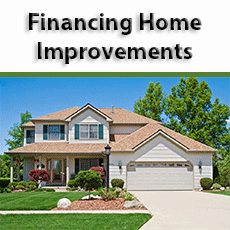 There are several ways of financing home improvements. However, before you even begin thinking of home improvement loans you should have a budget and try to stick to it. Keep in mind that most people go over-budget with a home improvement project, so add about 20% or more for your final costs.
There are several ways of financing home improvements. However, before you even begin thinking of home improvement loans you should have a budget and try to stick to it. Keep in mind that most people go over-budget with a home improvement project, so add about 20% or more for your final costs.
Here are the common ways of financing home improvements;
Financing Home Improvements: Home Equity Loan
A home equity line of credit is probably better for financing home improvements that a straight reverse mortgage. Also known as a HELOC, a line of credit enables you to borrow as you need during the draw period up to your credit limit. For home improvements, a short draw period would be sufficient, typically 5 years. Arrange enough to cover over-budget costs – you need not use it but the facility is there if you do.
You pay interest only on what you draw from the line of credit, so you can purchase home improvement materials as you require them, or pay contractors as the bills come in. A HELOC is repaid in full at the end of the period, or can be amortized for the full amount over the draw period. There will be a minimum monthly payment to cover at least the interest, and you can pay as much as you like above that.
If you are aged 62 or over, a HUD Home Equity Conversion Mortgage (HECM) might suit you better and the costs are less. You can also get a line of credit with this. It should be noted that with equity loans you will be unable to use all of the equity in your home.
Title 1 Home Improvement Loans
In the title 1 program, private lenders are insured by the FHA to provide home improvement loans. These are for up to $25,000 and a maximum period of 20 years. You can use the funds for genuine home improvements, but not luxuries such as spas, saunas and hot tubs. The interest rates tend to be around 50% of those of a private home improvement loan. You need not have equity in your home, but you must apply to a lender approved to offer a Title 1 loan.
Personal Loans
Personal loans offer lower interest rates than credit cards. Traditional banks tend to charge high interest rates for personal rates, but if you go online you can find a selection of lenders offering such loans at much lower rates.
Loans from Contractors
If you have some form of security, such as the equity in your home, some contractors will help with financing home improvements. If you take this route, make sure that the rates are lower than with a regular lender because many contractors get reward by lenders for passing your inquiry on.
Energy Efficiency Tax Credits
The government offers tax credits to a maximum total of $500 for installing energy efficient equipment in your home. This is not much, but it is something. Some credits can be higher if you upgrade to Energy Star equipment. Some states also contribute to the equipment costs. Check online for what your state offers – you may be in luck.
These are the more common methods of getting help financing home improvements. Always check the interest rates and costs of home improvement loans and go for the cheapest without putting your home at risk.



About The Author: Kenneth Le
More posts by Kenneth Le